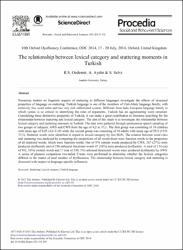| dc.contributor.author | Özdemir, R. Sertan | |
| dc.contributor.author | Aydın, Ahmet | |
| dc.contributor.author | Selvi, S. | |
| dc.contributor.editor | Millard, SK | |
| dc.contributor.editor | Rowley, DT | |
| dc.contributor.editor | Fenton, K | |
| dc.date.accessioned | 2019-10-18T18:43:36Z | |
| dc.date.available | 2019-10-18T18:43:36Z | |
| dc.date.issued | 2015 | |
| dc.identifier.issn | 1877-0428 | |
| dc.identifier.uri | https://dx.doi.org/10.1016/j.sbspro.2015.03.320 | |
| dc.identifier.uri | https://hdl.handle.net/11421/10347 | |
| dc.description | 10th Oxford Dysfluency Conference ODC 2014 -- JUL 17-20, 2014 -- St Catherines Coll, Oxford, UNITED KINGDOM | en_US |
| dc.description | WOS: 000380504100075 | en_US |
| dc.description.abstract | Numerous studies on linguistic aspects of stuttering in different languages investigate the effects of structural properties of language on stuttering. Turkish language is one of the members of Ural-Altaic language family, with relatively free word order and has very rich inflectional system. Different from Indo-European language family in which syntax is so critical in identifying the roles of arguments, Turkish has an agglutinating word structure. Considering these distinctive properties of Turkish, it can make a great contribution to literature searching for the relationship between stuttering and lexical category. The aim of this study is to investigate the relationship between lexical category and stuttering moments in Turkish. The data were gathered through spontaneous speech sampling of two groups of subjects; AWS and CWS from the age of 4; 2 to 37; 1. The first group was consisting of 10 children with mean age of 8; 25 (4; 2-11; 0) while the second group was consisting of 10 adults with mean age of 25; 3 (19; 937; 1). Stuttered words were identified in regard to lexical category by two SLPs. The relation between word class and stuttering was analyzed by comparing the proportions of all words those were function words to the proportion of all stuttered words, which were function words. Out of 976 content words produced by CWS, 267 (27%) were produced dysfluently and of 256 unbound functional words 47 (18%) were produced dysfluently. A total of 154 (out of 932, 16%) content words and 17 (out of 330, 5%) unbound functional words were produced dysfluently by AWS. A series of planned comparison two-tailed T-tests were performed to determine whether the lexicon categories differed in the matter of total number of dysfluencies. The relationship between lexical category and stuttering is discussed with respect to language-specific influences. | en_US |
| dc.language.iso | eng | en_US |
| dc.publisher | Elsevier Science BV | en_US |
| dc.relation.ispartofseries | Procedia Social and Behavioral Sciences | |
| dc.relation.isversionof | 10.1016/j.sbspro.2015.03.320 | en_US |
| dc.rights | info:eu-repo/semantics/openAccess | en_US |
| dc.subject | Stuttering | en_US |
| dc.subject | Lexical Category | en_US |
| dc.subject | Turkish Language | en_US |
| dc.title | The relationship between lexical category and stuttering moments in Turkish | en_US |
| dc.type | conferenceObject | en_US |
| dc.relation.journal | 10th Oxford Dysfluency Conference, Odc 2014 | en_US |
| dc.contributor.department | Anadolu Üniversitesi | en_US |
| dc.identifier.volume | 193 | en_US |
| dc.identifier.startpage | 351 | en_US |
| dc.identifier.endpage | 351 | en_US |
| dc.relation.publicationcategory | Konferans Öğesi - Uluslararası - Kurum Öğretim Elemanı | en_US |


















